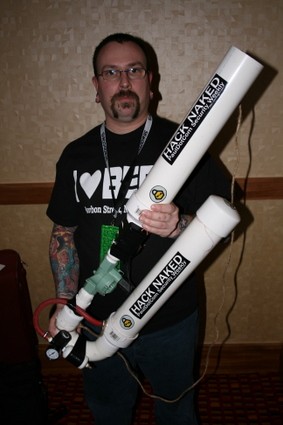
I caught up with [Larry] from pauldotcom.com and got a quick walk-through of his Shmooball gun. After several less successful attempts, this one worked pretty damn well and featured a distinctive sound that caused a notable glimmer of fear in the eyes of the speakers. *cough*[renderman]*cough*. Read on for the secrets of the Shmooball gun.

The gun is pneumatic, so pressure was supplied from a 7-800psi CO2 paintball gun through this quick disconnect. [Larry] needed an adapter to connect to the 1/4″ regulator input. He made the small chamber, with each connection, and found that it acted as a helpful expansion chamber for the gas supply.
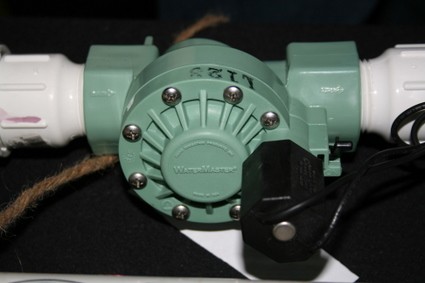
The lower pressure storage chamber is fed about 100psi from the regulator. To release the pressure to the firing chamber, he used this electric water sprinkler solenoid. These take around 12VDC and slightly slow the pressure expansion into the firing chamber
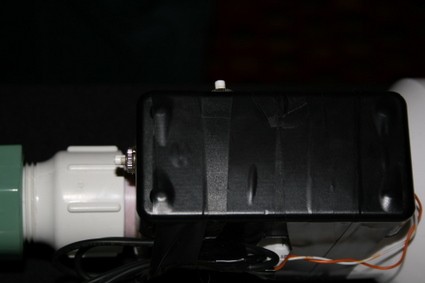
The trigger was built using a simple safety mechanism – two momentary push buttons have to be depressed to fire the sprinkler solenoid.
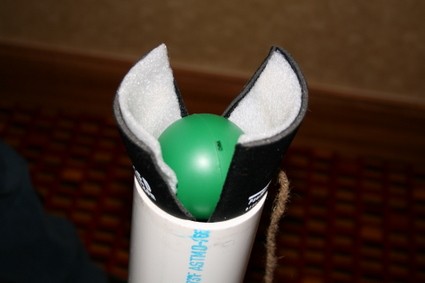
The get a good seal on the Shmooball, he cut down a beer cozy to act as reusable wadding.
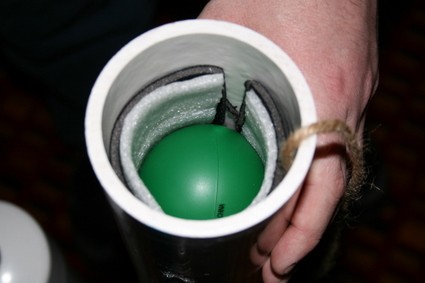
The wadding fits quite well around the 2.75″ Shmooball. The twine keeps the wadding from going the way of the Shmooball.

A velcro mounted laser pointer provides quick aim for chasing tricky speakers.
Thanks to [Larry] for giving us the tour!
















Were any modifications required for the solenoid to open quickly enough? I’ve done similar things on a smaller scale but have never been able to find a valve that opens quickly and cleanly enough for my liking.
renderman?
As in rendermandan, from TBCS?
Well, then… I know what I’m gonna be making… >:D
babau:
It is just a stock 1 inch sprinkler valve without modifications. I was short on time, and had never done the mod, so I knew it would work as-is. I didn’t even have the firing mechanism when I test fired before the con, and I just used the manual release.
As stock, the release is pretty bad, but the results were impressive regardless. Check out the talks by Jay Beale, Simple Nomad, Josh Wright and the closing ceremonies to see the results.
I’ve made quite a few Pneumatic Air cannons… the absolute *best* trigger mechanism is a custom “diaphragm valve”. I can’t really find any good links on the subject (I don’t think many people actually build these) but basically you have the barrel and then a substantially larger dia but shorter piece of pipe that goes around it to form the air chamber. the back ends are matched up with the large tube getting sealed around the outside of the barrel on the firing end. Looking at the back end it would be like a circle inside a circle with the barrel in the center and the air chamber around it. A sheet of rubber is placed flat against both of them and glued as well as nailed to the larger diameter pipe so that the center of the rubber just rests on barrel.
A pinhole is put in the rubber to allow air to trickle into the chamber created by the larger tube and the outside air then an end cap is placed over the whole end creating a small pocket of air on the outside of the rubber. A 1/4″ or larger valve is placed directly on the end cap, this is used both for filling the cannon as well as firing. this valve can be hand operator or an electric sprinkler valve, it wont matter.
As you fill it air builds up in the small end cap chamber and once the pressure is high enough it will seep through the pinhole and fill the larger tube chamber around the barrel as well.
Once it’s filled when you release the valve all of the air rushes out of the end cap chamber and creates a vacuum causing the rubber to get sucked back into the end cap and breaking the seal against the barrel allowing all of the air in the larger tube to rush directly into the barrel all at once.
This works exceptionally well for larger applications with 2″ or larger barrels since you can use a 4″ or 6″ air chamber and the value goes from completely closed to completely open an order of magnitude faster than a sprinkler valve.
We also made a version that used a piston as opposed to the end cap chamber so the release was completely mechanical. this worked just as well but required some precision machining to size and seal the piston properly.
I’ve also made several pneumatic cannons, but i prefer the piston variety. its true that they require careful construction, but they are definitely worth it. I have a golf ball cannon that was built around a 4″ piston that i built myself by hand (i.e. with a belt sander and some files, i wish i had a lathe!)
pistons have the advantage of huge airflow; a diaphragm is limited by how far it can flex, whereas a piston just moves out of the way entirely. if you can build a piston that can open fast enough, you can realize some pretty wicked pneumatic power. they work in a similar fashion to the diaphragms.
my golf ball cannon with the 4″ piston had a sprinkler valve pilot, which was itself modified for pneumatic actuation, so the sprinkler valve would open very quickly, which dumped the pilot volume behind the piston very quickly. the result? golf balls moving at 500 feet per second.
theres a nice little app somewhere on the web that will calculate the muzzle velocity of pneumatic cannons. i think its called gas gun design tool, but its been several years since i’ve used it. its worth a look if you can find it.
Twisttedsymphony’s right about the diaphram valve cannons, but a much simpler improvement would be to
pot up the exhaust hole for the solenoid, attach a hose to the valves upper chamber with a brass fitting, and attach the other end to an airgun (like the type you’d attach to a compressor)
its not as fast as a piston or diaphragm valve, but you’ll be amazed at how much better it performs than with the solenoid (plus you won’t need batteries)
Lastly, I should note that if you need to maintain the electronic triggering (ie, for remote control or something) another simple modification is to seal the hole just past the threads on the output side of the valve, then drill a 3-4mm hole in the internal vent line (this is usually on the side, just beneath the surface directly above the aforementioned hole) basically, the valve normally vents the upper diaphragm into the output to intentionally slow opening times and reduce water hammering. By venting the upper diaphragm straight to the atmosphere, the pressure above the diaphragm can drop more quickly, which will noticeably increase the speed of the valve.
(In case you haven’t guessed, air cannons have been one of my biggest hobbies)
Anyway, good luck.
The tool you’re thinking of is the Gas Gun Design Tool
http://thehalls-in-bfe.com/GGDT/
I’m working on a 0.5″ bore copper piston gun at the moment, should be able to take 400 psi if the piston valve can take it, and I can find a compressor that goes that high.
My father and I built something similar for my wedding. We made 9 cannons of PVC, except we used a manual ball valve for the trigger and threaded CO2 cartridges for the gas/pressure. Oh, and my would-be fusileers launched rose petals with it (gotta make the bride and her mom happy) when we made the grand entrance. They ended up costing about $25 each, but they’re re-usable, unlike these.
Oops — Sorry. I meant,
these:
http://www.boingboing.net/2007/04/04/rose-petal-cannon.html
Yeah. Not that impressive.
Unless you modded this valve, it probably honks when you fire the gun off, or at least honks when the air chamber gets low.
Take the ten minutes+5 bucks in parts to turn it into an air-operated valve instead of solenoid, you’ll be rewarded with MUCH more power, especially with an air storage chamber that size.
I agree with the comments on modifying the valve and ditching the solenoid. i’ve used this approach on all of my cannons including the pilot valve on the aforementioned golf ball cannon, and the performance gains are enormous. also you wouldn’t need to use a battery. i guess i forgot to mention it earlier, but its really worth it.
Dan, it’s impressive when it’s firing 6+ Shmooballs across a decently sized conference room at Joshua Wright’s junk.
And I don’t actually remember hearing it honk at all…
Mike, you’ve obviously never seen a real air cannon in action.
My light paintball cannon is significantly smaller than that, and at full power kicks harder than an average 12ga shotgun.
ditto. i have a paintball gun that fires at 700 fps. the sky’s the limit, friends.
I was not necessarily scared of it, it’s just that during my talk, it went off on the other side of the wall and was louder than I remember it being in person.
Was way cool though.
great post. i liked it…
Nice gun, but unmodded sprinkler valves won’t offer much performance, but still more than enough for shooting little balls at speakers :)
I wonder why nobody here refers to spud guns, as most development on pneumatic cannons is done by the spud gunning crowd (which I sort of belong to, heh).
There is a lot of research going on about piston valves, quick exhaust valves, modifying sprinkler/solenoid valves etc.
If people want to get into contact with more people developing crazy stuff, visit spudfiles.com…
hehehehehe
has eny body thought about adding cool led,s to this
If you were to touch the wires on the sprinkler valve to the power source does it open??
This bloke looks like a peadophile. Don’t let him near kids. His toy is just to attract kids.
how would you shoot multiple 3 or more object one after another?
Super Post, w�rde gerne den RSS Feed abonieren wie geht das???